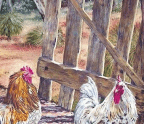
Gradations of colour and tone pretty much occur everywhere. I’ve probably said this about six squillion times. My arts practise is fundamentally built on gradations of colour. Often the painting itself will be entirely a series of gradations of colour, with some detail applied for realism.
Some gradations are quite obvious, and some are subtle. Even within the most subtle gradation of colour, there is a whole world of nuance. They are rarely just gradations in tone. There is usually a shift in hue as well. And often, several.
Throughout history, artists have been mesmerised by the illusion of dimension, particularly in figures and fabric. Being able to “gradate” colour and/or tone is necessary for this. You may not wish to paint “realistically”, but knowing the process and the “rules” around this process will allow you to expand your creativity. By this I mean you


